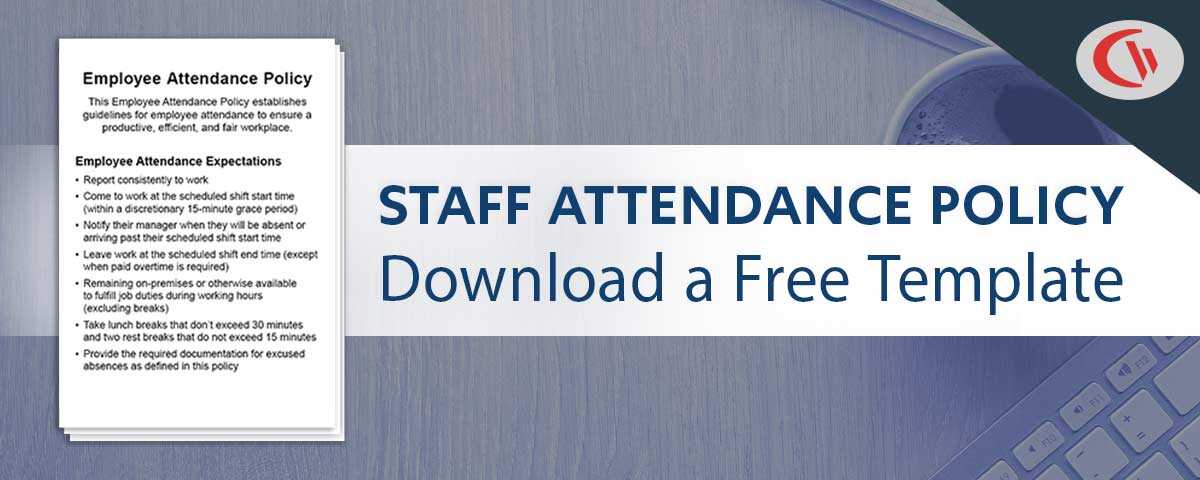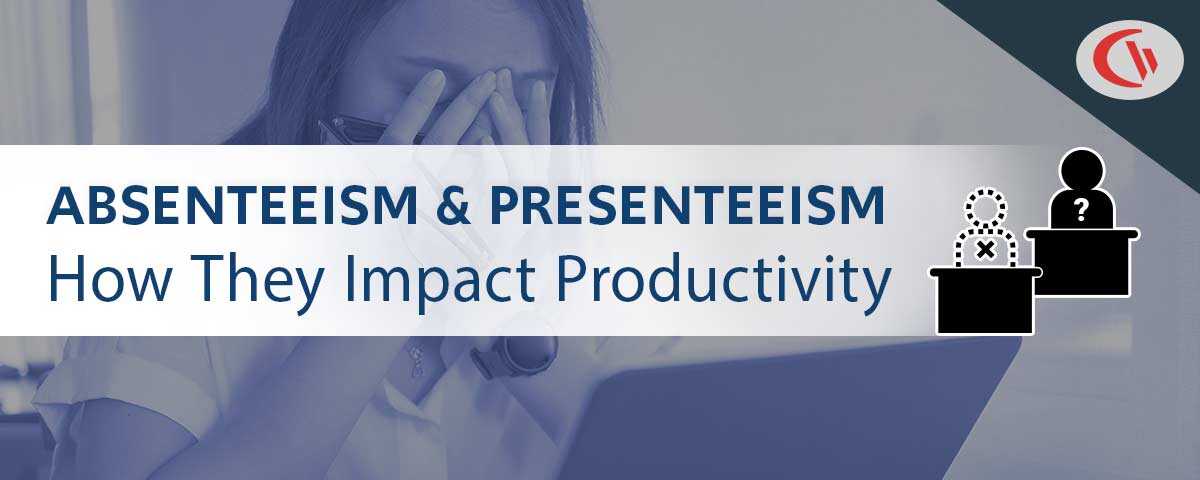Employee Attendance Policy Template (Free Download)

Running a bit late? Overslept or got caught in traffic? It happens to the best of us. In fact, over 1 in 4 workers (29%) admit to showing up to work late at least once a month.
While the occasional late start is understandable, chronic absenteeism and tardiness significantly drain productivity—The CDC estimates that absenteeism costs U.S. employers $225.8 billion annually, or $1,685 per employee!
In this article, we’ll explore how to develop a reasonable attendance policy. You’ll learn why it’s important, how it affects your team and business, and the steps to creating a policy that aligns with your company’s culture and values.
We’ll also provide a free employee attendance policy template you can download and customize to fit your company’s attendance management needs.
Track Employee Attendance With CurrentWare’s Workforce Productivity Tools
CurrentWare’s workforce productivity tools provide a valuable solution for verifying employee attendance. By leveraging detailed employee activity logs and real-time insights, managers can easily confirm that their team members are present and engaged, whether they’re remote or in-office.
- Verify Attendance
Monitor employee computer activity in real-time to quickly identify absenteeism or tardiness - Productivity Reports
Provide managers with comprehensive reports on web browsing habits, app usage, and team activity status to equip them with valuable insights for managing their team - Enforce RTO Policies
Works seamlessly for both remote and in-office employees, providing location-based insights such as # of days worked in the office each week and productivity by location
Get Your Free Employee Attendance Policy Template
- Set expectations for employee attendance
- Define excused vs unexcused absences
- Set a precedent for correcting attendance concerns
Get started today—Download the FREE template and customize it to fit the needs of your organization.
Why an Employee Attendance Policy is Important
- Sets Clear Expectations: An attendance policy sets out clear guidelines for attendance, punctuality, and reporting procedures, reducing ambiguity and potential conflict.
- Encourages Accountability: A well-defined policy means employees are accountable for their attendance. Knowing the impact of excessive absences can motivate employees to prioritize minimizing unscheduled absences and disruptions.
- Boosts Productivity: Over 70% of employers agree that absenteeism has a moderate to significant impact on productivity and revenue. Regular attendance contributes to overall productivity, allowing employees to be present and engaged, enabling teams to collaborate effectively, complete tasks on time, and run projects smoothly.
- Saves Money: Unscheduled absenteeism costs roughly $3,600 per year for each hourly worker and roughly $2,650 each year for salaried employees.
- Ensures Fairness and Consistency: A policy in place ensures attendance is managed fairly across the organization, with consistency in its application preventing favoritism and building trust with employees.
- Helps with Planning and Resource Management: Understanding attendance patterns allows management to better plan staffing needs, leading to improved resource allocation and minimizing disruption from employee absences.
- Supports Compliance and Legal Protection: A formal attendance policy aids the organization in complying with labor laws and regulations regarding leave and absence, and it can serve as evidence in case of attendance-related disputes or grievances.
- Enables Monitoring and Evaluation: Attendance policies provide a framework for monitoring patterns and performance, with data that can inform decisions related to promotions, raises, or disciplinary actions.
- Looks after Employee Well-being: A comprehensive policy can include provisions for sick leave, personal days, and other types of leave, demonstrating that the organization cares about its employees’ well-being.
How to Write Your Attendance Policy
The Problem With “No Fault” Policies
With “No Fault” attendance policies—also known as point-based attendance policies—employees accumulate punitive points for tardiness, absences, or leaving early, regardless of the reason. These points are reset regularly, but can trigger disciplinary action, including termination, if too many are accumulated within a time period.
While this type of attendance policy might seem objective and simple, it has drawn significant criticism for several reasons:
- Legal Liability: Points-based attendance policies may run afoul of protected absences under the FMLA and ADA. For example, two former AT&T Mobility workers filed a class action lawsuit that claims the no-fault attendance policy for retail employees unlawfully discriminates against pregnant women.
- Lack of Accountability: Employees may take advantage of the system by taking the maximum # of unexcused hours the system allows, leading to higher absenteeism. This can result in a decline in productivity and team morale as remaining employees are forced to cover for absent colleagues, making it difficult for teams to plan and manage workloads.
- Increased Administrative Burden: While no-fault policies are intended to simplify attendance tracking, they can create additional administrative challenges. HR may need to monitor attendance closely to identify patterns or potential abuses, increasing the workload for HR departments.
- Limited Flexibility: While “no fault” policies are designed to be flexible, they can sometimes limit an organization’s ability to accommodate legitimate absences. For instance, employees with chronic health issues may struggle under a system that treats all absences equally.
- Punitive Nature: Point-based systems can create a punitive environment where employees feel penalized for legitimate absences, such as illness or family emergencies. This can lead to stress and anxiety, potentially affecting overall morale and productivity.
- Encourages Dishonesty: Employees might be tempted to falsify reasons for absences or come to work when unwell to avoid accumulating points. This can undermine the integrity of the attendance policy and negatively impact workplace health.
- Increased Stress: The pressure to maintain attendance points can increase stress levels among employees, impacting their mental health and overall well-being.
- Disregards Variability in Needs: Different roles and responsibilities may require varying levels of attendance flexibility. A one-size-fits-all approach can be ineffective and detrimental.
“A “protected” absence is any absence because of an employee’s need for medical care, medical treatment, or as a result of a needed accommodation for a disability, including pregnancy-related disabilities. These absences cannot be held against employees because they are protected under various State and Federal anti-discrimination laws, such as the Family Medical Leave Act (FMLA), California Family Rights Act (CFRA), Americans with Disabilities Act, or Pregnancy Disability Leave Law. “
Julian Burns King, King & Siegel LLP
Set Expectations
Clearly state the company’s expectations around attendance including giving advance notice of unscheduled absences, work hours, start and end times and break times. Employees should know what is acceptable around punctuality and regular attendance. How many unexcused absences or tardiness is allowed, if any, and what is considered an excused vs unexcused absence.
Having clear expectations in place sets the standard and minimizes confusion or misinterpretation. It allows employees to know their part in attendance and for managers to enforce the policy consistently. Consider setting expectations for remote or hybrid work environments if applicable as that adds another layer of complexity to attendance tracking.
Consider a five-minute grace period before your company considers unreported late arrivals as tardiness. This helps provide some much-needed leeway for arriving late due to unforeseen circumstances.
Procedures for Reporting
Include clear instructions on how employees should report an absence, tardiness or early departure. For example you may require employees to notify their supervisor via email, phone or an HR management platform within a certain timeframe before their shift. Also, explain when they need to provide additional documentation such as a doctor’s note for certain absences.
Standardized procedures ensure employees know what to do when they can’t come to work and allows managers to plan ahead for absences. This minimizes disruption to workflows and allows supervisors to allocate resources more effectively. Plus, these procedures are documentation for any attendance issues that may come up later.
How You’ll Address Poor Attendance
Emergencies and high-priority life events happen. While perfect attendance can’t be guaranteed, and you want to be mindful of work-life balance, you need a plan to address an unexcused or unreported absence when it occurs.
While a good attendance record isn’t everything, allowing employee attendance infractions to go unaddressed can lead to inconsistent policy enforcement, excessive absenteeism, and productivity concerns for your business.
Clearly outline the consequences of unexcused absences, tardiness or early departures in the attendance policy. Have a progressive disciplinary policy that starts with verbal or written warnings and can escalate to suspension or termination if the behavior continues. Make sure the consequences are proportionate to the attendance issue.
By stating the penalties clearly, employees know how their attendance impacts their employment with your company. A defined process helps to maintain fairness and consistency in how infractions are handled and reduces the risk of favoritism or arbitrary decision making.
Consult With Legal Counsel on Protected Absences & Other Considerations
Make sure to include a section that covers protected absences such as those covered by the Family and Medical Leave Act (FMLA), Americans with Disabilities Act (ADA) or other applicable labor laws. These types of absences cannot be disciplined as they are protected by law. Make it clear that employees can take time off for medical reasons, pregnancy or other qualifying circumstances without penalty.
Compliance with employment laws not only protects the company from potential legal liability but also shows the company is committed to supporting employees through legitimate personal challenges. The policy should state the company will provide accommodations where possible such as modified work hours or medical leave to create a more inclusive and supportive workplace.
Be Flexible Where Possible
Research has indicated that employee attendance rates can be positively impacted by corporate policies that support a healthy work-life balance, including flexible working options and the ability to take time off as needed.
Consider including flexibility in the attendance policy to accommodate different life situations. This could be flexible working arrangements, remote work options, or personal days. Having some flexibility can reduce absenteeism as employees feel more in control of their personal responsibilities without compromising their work responsibilities.
Including flexibility where possible is a modern approach to employee management and can lead to higher job satisfaction and retention. But be sure to set boundaries around flexibility so it doesn’t become an abuse of the system. Define how and when flexibility can be used and what expectations are around tracking time in those situations.
Paid and Unpaid Leave
Break down the different types of paid and unpaid leave available to employees such as vacation days, personal days, sick leave and maternity/paternity leave. Include how these days are accrued, used and carried over from one year to the next. Explain the process for requesting and getting approval for leave time.
Having paid and unpaid leave policies in place ensures employees know their entitlements and how to access them. This transparency reduces misunderstandings and frustration especially when employees are planning for extended absences or vacations. It also allows managers to plan resources more effectively knowing when employees will be away and ensure proper coverage is in place.
Be Transparent with Attendance Tracking
Explain how employee attendance will be tracked and monitored. Whether through timesheets, punch clocks or attendance monitoring software, employees should know the methods used to record their attendance. Give them access to their own attendance records so they can stay up to date and avoid misunderstandings.
Transparent attendance tracking builds trust between employees and management as employees are more likely to follow the policy when they know how their time is being tracked. It also ensures consistency in how attendance issues are handled as accurate records allow managers to enforce the policy fairly across the board.
Communicate the Policy
Make sure the attendance policy is communicated to all employees from day one. Include it in the employee handbook and discuss it during onboarding. Provide regular reminders or updates whenever the policy is changed or reinforced. Keep the language simple and clear so there’s no confusion.
By communicating the policy clearly employees can’t claim ignorance if issues arise. It ensures everyone is on the same page and creates a culture of accountability. A communicated policy reduces the chance of disputes and provides clear guidelines for employees and managers.
Encourage Openness
Create an environment where employees feel comfortable to talk about any issues that might impact their attendance. Whether it’s health concerns, family obligations or personal struggles employees should feel they can approach management or HR for help. This open conversation can address issues before they become problems.
Open communication shows the company cares about its employees and will provide solutions when needed. This proactive approach can reduce absenteeism by addressing the underlying causes. It also builds stronger relationships between management and staff and creates a more positive work environment.
Review and Update Regularly
A good attendance policy shouldn’t be set in stone. Review and update the policy regularly to ensure it’s still relevant and compliant with changing employment laws or company practices. Ask employees for feedback to understand any challenges or issues they have with the policy.
By keeping the policy current you ensure it continues to meet the needs of the business and employees. Regular reviews also gives you the opportunity to refine any areas that aren’t working as intended so you can improve your approach to attendance management over time.
Case Study
From Hunch to Hard Evidence—How CurrentWare Informs HR Investigations
One of the many responsibilities of human resources professionals is to conduct investigations on a wide range of concerns, including harassment, discrimination, theft, misuse of company resources, and potential policy violations.
Ensuring fairness, accuracy, and consistency in the HR investigations process fosters a culture of trust and respect, where everyone feels comfortable reporting issues, knowing they will be taken seriously.
CurrentWare is the digital witness HR pros need to gather proof of employee misconduct. By leveraging CurrentWare’s employee investigations capabilities, they uncover what truly happened in an impartial and objective manner, ensuring a safe working environment for all employees and preventing future incidents.
Track Employee Attendance With CurrentWare’s Workforce Productivity Tools
CurrentWare’s workforce productivity tools provide a valuable solution for verifying employee attendance. By leveraging detailed employee activity logs and real-time insights, managers can easily confirm that their team members are present and engaged, whether they’re remote or in-office.
- Verify Attendance: Monitor employee computer activity in real-time to quickly identify absenteeism or tardiness
- Productivity Reports: Provide managers with comprehensive reports on web browsing habits, app usage, and team activity status to equip them with valuable insights for managing their team
- Enforce RTO Policies: Works seamlessly for both remote and in-office employees, providing location-based insights such as # of days worked in the office each week and productivity by location


